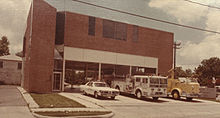
Jacinto City is a city in Harris County, Texas, United States, east of the intersection of Interstate 10 and the East Loop of Interstate 610. Jacinto City is part of the Houston–Sugar Land–Baytown metropolitan area and is bordered by the cities of Houston and Galena Park. The population was 9,613 at the 2020 census.

Stephen F. Austin High School is a secondary school located at 1700 Dumble Street in Houston, Texas, United States. The school handles grades nine through twelve and is a part of the Houston Independent School District. In 2013, the school was rated "Met Standard" by the Texas Education Agency.
Harrisburg is a community now located within the city of Houston, Texas.

Heights High School, formerly John H. Reagan High School, is a senior high school located in the Houston Heights in Houston, Texas. It serves students in grades nine through twelve and is a part of the Houston Independent School District.

Second Ward is a historical political district ward in the East End community in Houston, Texas. It was one of the four original wards of the city in the nineteenth century. The community known as the Second Ward today is roughly bounded by Buffalo Bayou to the north, Lockwood Avenue to the east, and railroad tracks to the south and west, although the City of Houston's "Super Neighborhood" program includes a section east of Lockwood.

César E. Chávez High School is a secondary school located at 8501 Howard Drive in the Allendale neighborhood in Houston, Texas, United States.

Phillis Wheatley High School is a secondary school located at 4801 Providence Street in Houston, Texas, United States with a ZIP code of 77020. Wheatley is a part of the Houston Independent School District. Wheatley, named after Phillis Wheatley, is located inside the 610 Loop in the Fifth Ward.
Pecan Park is a neighborhood in Houston, Texas.

Charles H. Milby High School is a public secondary school at 1601 Broadway in the East End, Houston, Texas, United States. It serves grades 9 through 12, and is a part of the Houston Independent School District.

Ebbert L. Furr High School is a secondary school located in Houston, Texas, United States. Furr, which serves grades 9 through 12, is a part of the Houston Independent School District.

Clinton Park is a neighborhood located in Houston, Texas. Clinton Park is located outside the 610 Loop in eastern Houston. Clinton Park is predominantly African-American. Carolyn Campbell of KHOU-TV described Clinton Park, close to the Port of Houston, as "small" and "isolated."

Glenbrook Valley is a subdivision located in Houston, Texas, United States.
Near Northside is a historic neighborhood located in Northside, Houston, Texas. Near Northside is primarily occupied by people of Hispanic descent.

East End Houston, managed by the East End District (EED), is a district in eastern Houston, Texas, United States, located between the eastern edge of downtown to the Port of Houston and South to Hobby Airport. The District is home to Houston's early history and industry and is the site of Harrisburg, the seat of government for the Republic of Texas in 1836. East End Houston consists of many different ethnic groups, including Hispanic, Asian, White, and African American. Latinos make up more than half of the 100,512 residents, The area includes two of Houston's oldest Hispanic neighborhoods, Magnolia Park and Second Ward.
Port Houston is a neighborhood located on the East Side of Houston, Texas, United States.

Denver Harbor is a historic community located in eastern Houston, Texas, United States near the Houston Ship Channel. The community, bounded by Wallisville Road, the Union Pacific Railroad, and the Port Terminal Railroad Association, was first settled in the 1890s and platted in 1911 and 1913. The community includes many historic bungalow and cottage homes.
The Airline Improvement District is a management district in unincorporated Harris County, Texas, United States, in Greater Houston and is located entirely within the postal zip code of 77037.
Houston/Trinity Gardens is an African-American neighborhood in Houston.
Magnolia Park Transit Center is a light rail and bus station in Houston, Texas on the METRORail system. It is the eastern terminus of the Green Line and is located on Harrisburg Boulevard at 70th Street in Magnolia Park, in the East End. Nearby the station are many restaurants and taquerias. The Magnolia Park shopping center is a half block down the street at Harrisburg and Sgt. Macario Garcia Drive.





















